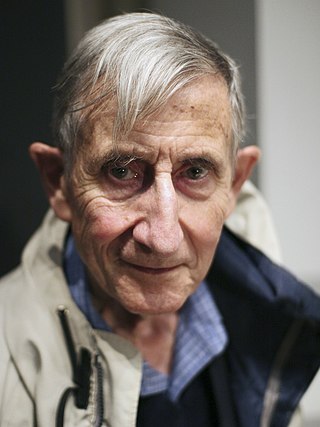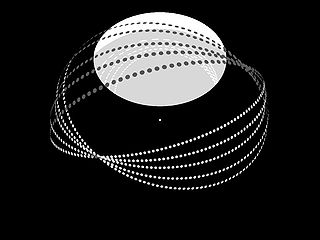
Freeman John Dyson was a British-American theoretical physicist and mathematician known for his works in quantum field theory, astrophysics, random matrices, mathematical formulation of quantum mechanics, condensed matter physics, nuclear physics, and engineering. He was professor emeritus in the Institute for Advanced Study in Princeton and a member of the board of sponsors of the Bulletin of the Atomic Scientists.

The Kardashev scale is a method of measuring a civilization's level of technological advancement based on the amount of energy it is capable of harnessing and using. The measure was proposed by Soviet astronomer Nikolai Kardashev (1932–2019) in 1964 and was named after him.

Star Maker is a science fiction novel by British writer Olaf Stapledon, published in 1937. The book describes a history of life in the universe, dwarfing in scale Stapledon's previous book, Last and First Men (1930), a history of the human species over two billion years. Star Maker tackles philosophical themes such as the essence of life, of birth, decay and death, and the relationship between creation and creator. A pervading theme is that of progressive unity within and between different civilisations.
Star lifting is any of several hypothetical processes by which a sufficiently advanced civilization could remove a substantial portion of a star's matter which can then be re-purposed, while possibly optimizing the star's energy output and lifespan at the same time. The term appears to have been coined by David Criswell.
A matrioshka brain is a hypothetical megastructure of immense computational capacity powered by a Dyson sphere. It was proposed in 1997 by Robert J. Bradbury (1956–2011). It is an example of a class-B stellar engine, employing the entire energy output of a star to drive computer systems. This concept derives its name from the nesting Russian matryoshka dolls. The concept was deployed by Bradbury in the anthology Year Million: Science at the Far Edge of Knowledge.

An Alderson disk is a hypothetical artificial astronomical megastructure, like Larry Niven's Ringworld and the Dyson sphere. The disk is a giant platter with a thickness of several thousand miles. The Sun rests in the hole at the center of the disk. The outer perimeter of an Alderson disk would be roughly equivalent to the orbit of Mars or Jupiter. According to the proposal, a sufficiently large disk would have a larger mass than its Sun.
Xenoarchaeology, a branch of xenology dealing with extraterrestrial cultures, is a hypothetical form of archaeology that exists mainly in works of science fiction. The field is concerned with the study of the material remains to reconstruct and interpret past life-ways of alien civilizations. Xenoarchaeology is not currently practiced by mainstream archaeologists due to the current lack of any material for the discipline to study.

A megastructure is a very large artificial object, although the limits of precisely how large vary considerably. Some apply the term to any especially large or tall building. Some sources define a megastructure as an enormous self-supporting artificial construct. The products of megascale engineering or astroengineering are megastructures.
Megascale engineering is a form of exploratory engineering concerned with the construction of structures on an enormous scale. Typically these structures are at least 1,000 km (620 mi) in length—in other words, at least one megameter, hence the name. Such large-scale structures are termed megastructures.

Stellar engines are a class of hypothetical megastructures which use the resources of a star to generate available work. For instance, they can use the energy of the star to produce mechanical, electrical or chemical work or they can use the impulse of the light emitted by the star to produce thrust, able to control the motion of a star system. The concept has been introduced by Bădescu and Cathcart. The variants which produce thrust may accelerate a star and anything orbiting it in a given direction. The creation of such a system would make its builders a type-II civilization on the Kardashev scale.

Accelerando is a 2005 science fiction novel consisting of a series of interconnected short stories written by British author Charles Stross. As well as normal hardback and paperback editions, it was released as a free e-book under the CC BY-NC-ND license. Accelerando won the Locus Award in 2006, and was nominated for several other awards in 2005 and 2006, including the Hugo, Campbell, Clarke, and British Science Fiction Association Awards.

A Dyson tree is a hypothetical genetically engineered plant capable of growing inside a comet, suggested by the physicist Freeman Dyson. Plants may be able to produce a breathable atmosphere within the hollow spaces of the comet, utilising solar energy for photosynthesis and cometary materials for nutrients, thus providing self-sustaining habitats for humanity in the outer solar system analogous to a greenhouse in space, a shell grown by a mollusc or the actions of thermogenic plants, such as the skunk cabbage or the voodoo lily.
Stellar engineering is a type of engineering concerned with creating or modifying stars through artificial means.
An infrared excess is a measurement of an astronomical source, typically a star, that in their spectral energy distribution has a greater measured infrared flux than expected by assuming the star is a blackbody radiator. Infrared excesses are often the result of circumstellar dust heated by starlight and reemitted at longer wavelengths. They are common in young stellar objects and evolved stars on the asymptotic giant branch or older.

Supernovae, extremely powerful explosions of stars, have been featured in works of fiction since at least the early 1900s.
Engineering on an astronomical scale, or astronomical engineering, i.e., engineering involving operations with whole astronomical objects, is a known theme in science fiction, as well as a matter of recent scientific research and exploratory engineering.

Technosignature or technomarker is any measurable property or effect that provides scientific evidence of past or present technology. Technosignatures are analogous to biosignatures, which signal the presence of life, whether intelligent or not. Some authors prefer to exclude radio transmissions from the definition, but such restrictive usage is not widespread. Jill Tarter has proposed that the search for extraterrestrial intelligence (SETI) be renamed "the search for technosignatures". Various types of technosignatures, such as radiation leakage from megascale astroengineering installations such as Dyson spheres, the light from an extraterrestrial ecumenopolis, or Shkadov thrusters with the power to alter the orbits of stars around the Galactic Center, may be detectable with hypertelescopes. Some examples of technosignatures are described in Paul Davies's 2010 book The Eerie Silence, although the terms "technosignature" and "technomarker" do not appear in the book.

A planetary civilization or global civilization is a civilization of Type I on the Kardashev scale. This type of civilization is likely to be reliant on renewable energy sources such as stellar power, as well as powerful non-renewable sources such as nuclear fusion. A Type I civilization's energy consumption level is roughly equivalent to the solar insolation on Earth (between 1016 and 1017 watts) – around 3 orders of magnitude higher than that of contemporary humanity (around 2×1013 as of 2020).

Rendezvous with the Future is a documentary series commissioned by Bilibili and produced by BBC Studios which explores the science behind the science fiction of author Liu Cixin. The series premiered in China on 16 November 2022 and has been watched by a combined audience of more than 80 million.

An artificial planet is a proposed stellar megastructure. Its defining characteristic is that it has sufficient mass to generate its own gravity field that is strong enough to prevent atmosphere from escaping, although the term has been sometimes used to describe other types of megastructures that have self-sufficient ecosystems. The concept can be found in many works of science-fiction.














